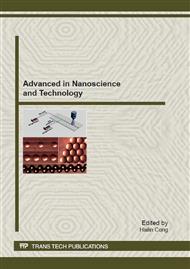[1]
Y.H. Rezenom, A.D. Wellman, L. Tilstra, C.D. Medley, S.D. Gilman, Separation and detection of individual submicron particles by capillary electrophoresis with laser-light-scattering detection, Analyst. 132 (2007) 1215–1222.
DOI: 10.1039/b709509k
Google Scholar
[2]
W.J. Chen, K. Mou, B. Xu, X. M. Ling, J. R. Cui, P. Xu, Capillary electrophoresis for screening of 20S proteasome inhibitors, Analytical Biochemistry 394 (2009) 62–67.
DOI: 10.1016/j.ab.2009.07.020
Google Scholar
[3]
E. Hurtado-Fernandez, M. Gomez-Romero, A. Carrasco-Pancorbo, A. Fernandez-Gutierrez, Application and potential of capillary electroseparation methods to determine antioxidant phenolic compounds from plant food material, Journal of Pharmaceutical and Biomedical Analysis. 53 (2010).
DOI: 10.1016/j.jpba.2010.07.028
Google Scholar
[4]
M. Horka, F. Ruzicka, A. Kubesova, V. Hola, K. Slais, Capillary electrophoresis of conidia from cultivated microscopic filamentous fungi, Anal. Chem. 81 (2009) 3997–4004.
DOI: 10.1021/ac900374v
Google Scholar
[5]
D. Andreyev, E. A. Arriaga, Simultaneous laser-induced fluorescence and scattering detection of individual particles separated by capillary electrophoresis, Anal. Chem. 79 (2007) 5474–5478.
DOI: 10.1021/ac070770u
Google Scholar
[6]
F.K. Liu, Extremely highly efficient on-line concentration and separation of gold nanoparticles using the reversed electrode polarity stacking mode and surfactant-modified capillary electrophoresis, Analytica Chimica Acta. 694 (2011) 167–173.
DOI: 10.1016/j.aca.2011.03.056
Google Scholar
[7]
J.S. Baker, L.A. Colon, Influence of buffer composition on the capillary electrophoretic separation of carbon nanoparticles, Journal of Chromatography A. 1216 (2009) 9048–9054.
DOI: 10.1016/j.chroma.2009.08.063
Google Scholar
[8]
D.T.R. Stewart, M. D Celiz, G. Vicente, L.A. Colon, D.S. Aga, Potential use of capillary zone electrophoresis in size characterization of quantum dots for environmental studies, Trends in Analytical Chemistry. 30 (2011) 113–122.
DOI: 10.1016/j.trac.2010.10.005
Google Scholar
[9]
N.G. Vanifatova, B.Y. Spivakov, J. Mattusch, R. Wennrich, Size separation of silica nanospheres by means of capillary zone electrophoresis, Talanta. 59 (2003) 345–353.
DOI: 10.1016/s0039-9140(02)00523-4
Google Scholar
[10]
M.B. Muller, J.P. Quirino, P.N. Nesterenko, P.R. Haddad, S. Gambhir, D. Li, G.G. Wallace, Capillary zone electrophoresis of graphene oxide and chemically converted graphene, Journal of Chromatography A. 1217 (2010) 7593–7597.
DOI: 10.1016/j.chroma.2010.09.069
Google Scholar
[11]
S.P. Radko, M. Stastna, A. Chrambach, Capillary zone electrophoresis of sub-μm-sized particles in electrolyte solutions of various ionic strengths: size-dependent electrophoretic migration and separation efficiency, Electrophoresis. 21 (2000).
DOI: 10.1002/1522-2683(200011)21:17<3583::aid-elps3583>3.0.co;2-q
Google Scholar
[12]
H.L. Cong, W.X. Cao, Colloidal crystallization Induced by capillary force, Langmuir. 19 (2003) 8177–8181.
DOI: 10.1021/la0344480
Google Scholar
[13]
L.L. Yang, H.L. Cong, W.X. Cao, Preparation of mono-dispersed colloids of p(st-mma-spmap) by soap-free emulsion copolymerization, ACTA POLYMERICA SINICA. 4 (2005) 223–226.
Google Scholar


